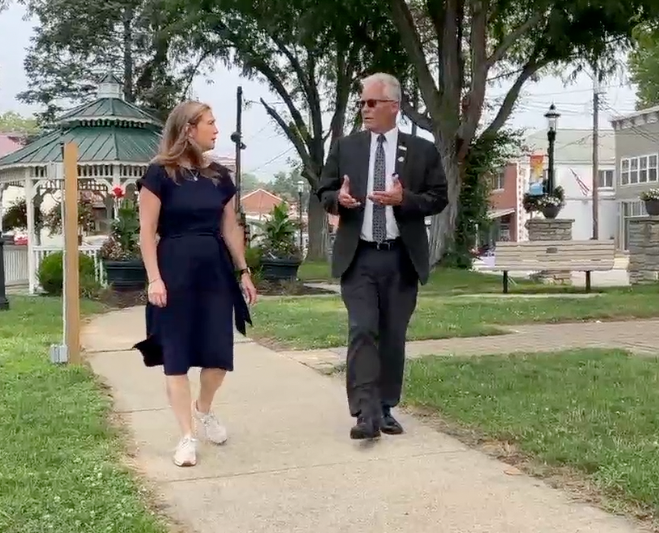PIERCE TOWNSHIP, Ohio — Clermont County officials are concerned about the safety of their drinking water and the lack of emergency readiness at the former Walter C. Beckjord power plant site, where billions of tons of leftover coal ash are stored on the Ohio River.
“This is something that should scare the hell out of everybody,” said Pierce Township Trustee Allen Freeman. “That pollution is sitting there right next to your water.”
The WCPO 9 I-Team discovered that one of two interceptor wells meant to protect county drinking water from a migrating sulfate plume has not been operational since 2023.

Leftover coal ash is stored in unlined ash ponds in the river’s floodplain. They are directly upstream from the county’s primary drinking water wells.
WATCH: We talk with officials concerned about the plant's potential contamination
“The drinking water fields can be completely polluted and make them useless to the county,” Freeman said. “You’re also sitting on top of an aquifer, which is a very valuable source of water. If you destroy that, it is very difficult and expensive to have to fix it. Not to mention that the sulfate, one, tastes bad, and it’s bad for your health too.”
Separately, local officials also worry about the lack of disaster drills and an outdated emergency action plan. They say fire and emergency crews have not conducted yearly practice drills despite it being required by Ohio law.

Pierce and Anderson Township trustees wrote Gov. Mike DeWine a joint letter in May asking for help. They received no response until the WCPO 9 I-Team reached out on their behalf.
“The site sits upriver from the Clermont County water ground wells, the surface water intakes for Northern Kentucky and Greater Cincinnati water. The site poses a potentially significant risk to the drinking water of hundreds of thousands of people … I feel there has been a significant lack of oversight by the ODNR (Ohio Department of Natural Resources) and OEPA (Ohio Environmental Protection Agency) regarding the dam safety program, the site, the permit compliance and adherence to the EAP (emergency action plan) reviewed and approved by your agency,” Pierce Township Fire Chief Craig Wright wrote in a Nov. 20 email to the ODNR.

‘It appears that there is no oversight’
Built in the 1950s as a coal-burning giant, the Beckjord plant pumped electricity to hundreds of thousands of homes and businesses across Southwest Ohio for decades.
Duke Energy closed the plant in 2014 and sold the 1,443-acre site four years later to Missouri-based Commercial Liability Partners and its subsidiary, the New Richmond Development Corp.
CLP did not respond to a request for comment. The company specializes in rehabilitating former power plants and hopes to develop a portion of the Beckjord site. But the cleanup has been controversial.

Residents complained about blowing clouds of coal fly ash in July 2020. Fly ash is the by-product of burned coal. According to the EPA, the powdery substance may contain low levels of radioactivity and contaminants such as mercury, cadmium and arsenic.
During demolition in February 2021, the main Beckjord smokestack crashed into the Ohio river, which is the main water source for 5 million people. Cleanup of the submerged debris took months.
In 2023, the I-Team discovered that two wells for monitoring groundwater for contamination were missing or damaged, but county officials were unaware.

“It appears that there is no oversight,” said New Richmond resident Tom Belmont Jr., who lives across the street from the ash pits and said his house has been damaged by blowing fly ash over the past five to six years.
“I have a black roof, black concrete,” Belmont said. “It has corrosive qualities. It’s actually eaten the wood.”
This spring, after the worst flooding in decades, local officials worried that rising water had directly mixed with that buried ash.
“Our communities … have been directly impacted by recent Ohio River flooding and remain vulnerable due to the region’s industrial legacy and riverside location,” Pierce and Anderson Township trustees wrote in a May 23, 2025 letter to DeWine.

“The ongoing absence of cooperation poses a risk not only to first responders, but to the health and safety of our residents,” the letter stated.
The trustees asked DeWine to direct the ODNR and OEPA to immediately provide the emergency response and contingency plans for the Beckjord site, to facilitate a multi-agency briefing for emergency services and to establish a schedule for joint emergency training and tabletop exercises specific to the Beckjord site and regional Ohio River response planning.
Freeman said the governor’s office did not respond for six months, until the I-Team got involved.
Days after the I-Team sent an email to DeWine’s office, his spokesperson, Dan Tierney, wrote on Nov. 18, “Thank you for flagging this. Our regional staff is calling the trustees to provide an update. We are researching what authority and assistance the state may have in this area. We will provide the trustees a formal, written response when complete.”

Pierce Township officials said DeWine’s office and the ODNR reached out to them last week.
In emails obtained by the I-Team, Wright, the township fire chief, wrote that if an emergency occurred at Beckjord, he would be operating off an untested plan that contained incorrect information.
In contrast, when Duke Energy owned the Beckjord site, Wright said he met every year to practice an emergency plan that was regularly updated.
“At the end of the day or night, when an emergency occurs, I will be the individual on site that responded and in command of the situation … our community partners and neighboring agencies will be there to support us and the incident, but will the state of Ohio?” Wright wrote.

Mia Kannick, a manager with ODNR’s dam safety program, wrote that she was in contact with CLP earlier this year about updating the emergency action plan.
“They are working on revising the EAP, and we should receive a draft by the end of the year,” Kannick wrote in a Nov. 21 email. “We would also be willing to participate in any further discussions about the EAP or take part in meetings or exercises to improve the safety of the ash ponds.”
‘We need help’
For more than 30 years, the owners of Beckjord have tested groundwater four times a year and sent those monitoring reports to the county and the Ohio EPA. The site has more than 25 monitoring wells spread across the expansive area, testing for contaminants such as sulfate and boron.
County officials rely on those groundwater test results to track contaminants and measure if water levels are high enough to come into direct contact with coal ash residuals.
Two wells that monitor groundwater were either missing or damaged for several months in 2022, but local officials never knew about it until the I-Team contacted them.
Recently, those groundwater monitoring reports have been filed several months late. No reports for 2025 had been filed with the Ohio EPA as of mid-October.
"I just sent out the Q1 groundwater report for Beckjord ... I’ve been thinking about your plan to put a deadline for submitting these reports in the future. Given my abysmal track record, I don’t blame you. However, instead of a fixed calendar date, would it be possible to have them due 45 days after receiving the last lab report," Gemini Engineering environmental manager Linda Denison wrote in an Oct. 23, 2025, email to the Ohio EPA.

After the I-Team asked for the reports, the OEPA provided the reports for the first and second quarters in November.
“When we called and when we asked, ‘Where are they? They’re like 'Don’t worry, they’re on their way… fortunately, when you called, they got it taken care of,” Freeman said. “It shows you the lackadaisical approach that OEPA is taking toward this particular site and the lack of care and concern that the state of Ohio is showing. And that is infuriating.”
The owner of the company that purchased Beckjord is also affiliated with the company that tests its groundwater. Ron Froh is listed as CEO and president of CLP and of Gemini Engineering, according to the company websites.

In 2019, Clermont County officials insisted that CLP install a second, new interceptor well to divert water contaminated by a nearby ash pond away from the county’s drinking water wells. It served as a backup to protect their water supply in case the first well failed.
But recent groundwater monitoring test reports state that the first interceptor well has not been operational since 2023.
“The non-operating interceptor well (IW-1) was not gauged due to previous well-casing repairs preventing the water level equipment from accessing the well,” according to the second quarter 2025 report.

When the I-Team asked the Ohio EPA about this, a spokesperson said, “Well 1 (IW-1) is currently operating, but …(the owner) has been unable to establish a way to measure water depth within the well.”
“While there are no immediate concerns, Ohio EPA staff will review the 2025 quarterly reports recently submitted … and evaluate ways the company can measure water depth at this location.”
The Ohio EPA may not be concerned, but others are.
“We are equally concerned by the fact that the reports continue to state that the second interceptor well is not functioning, and have previously raised this issue with (the owner) and Ohio EPA. We continue to assess our options and intend to formally discuss the Beckjord site with (the owner),” said Clermont County Commission President David Painter.
Environmental attorney David Altman is also worried. He represents more than 100 Pierce Township residents, Neighbors Opposed to Pit Expansion, or NOPE, in their lawsuit against CLP over the contaminated waste disposal.
“The so-called 'interceptor' wells were barely an adequate defense to the waves of coal ash contamination that flow toward Clermont County’s drinking water wells from the unlined coal ash contamination that CLP has left behind,” Altman said.
“To now find out that one of the two wells has not even been operating for two years is an outrage and a failure of Ohio EPA’s duty to inform the public about environmental health and safety issues,” Altman said. “The real outrage is Ohio EPA will not even ‘come clean’ and admit that it has no authority under state law to even require the wells to operate.”
Freeman said the township has no enforcement authority to monitor the wells at the Beckjord site.
“This is again that moment of us feeling like we’re alone,” Freeman said. “We’re waving the red flag and saying we need help, and no one seems to be that interested in showing up.”




